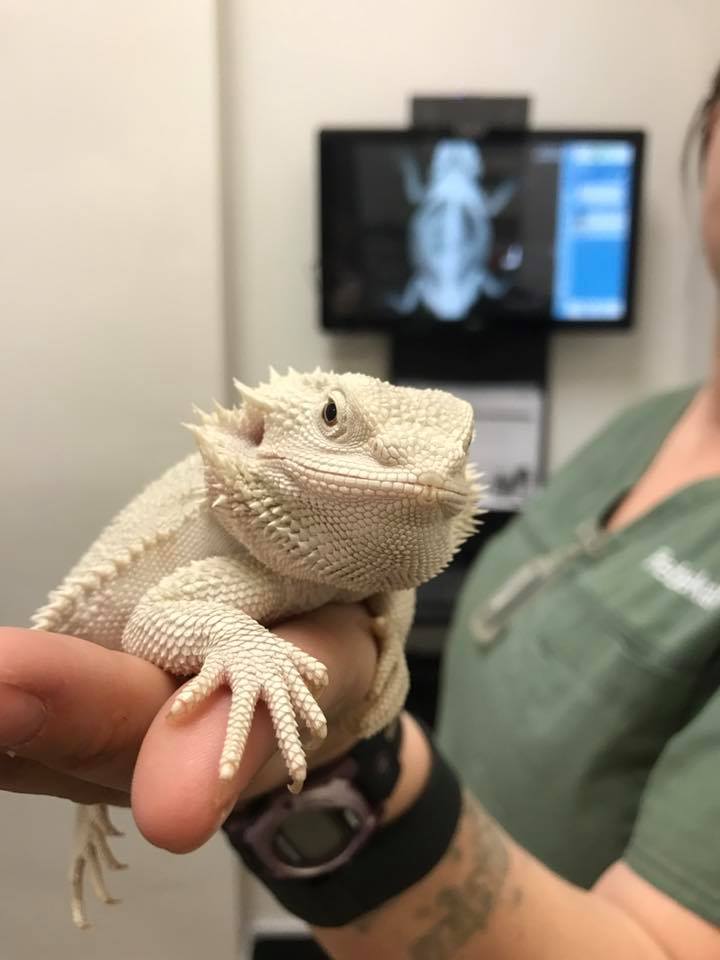|
BEARDED DRAGONS - A GREAT PET!
We see a lot of bearded dragons and highly recommend them as pets.
Are omnivores: eating a mixture of plants and animal products, but the bulk of the diet is protein based. Common problems are similar as with other reptiles and include malnutrition from improper lighting and feeding. They often suffer from parasite infections and should be examined yearly. Bring a fecal sample! Hatchling bearded dragons have to be fed very small live food which sometimes can be difficult to obtain and hatchlings are more fragile. It is best to start with a slightly older dragon that can be fed readily available food.
A QUICK FACT SHEET
ENVIRONMENT: Desert of Australia
LIFESPAN: 10+ years of age
SEXING: Males have a beard that turns black during the breeding season
Males have pre-anal and femoral pores
HOUSING: – A large aquarium with a natural substrate bottom and multiple climbing branches and hide boxes should be used.
The type of substrate is often debated but may people advocate bedding such as sand, outdoor carpet, decomposed granite, paper towels, newspaper… Regardless of the type of substrate used, hygiene is the most important aspect to consider. You should choose a substrate that you can keep clean and fresh for your dragon.
Avoid: kitty litter, bird litter (such as corncob or walnut shells) and wood shavings.
LIGHTING: Full spectrum lighting can only be supplied in the form of fluorescent bulbs and the bulb must supply UVB spectrum light. The light should be ~18 inches from the cage.
 A basking light should be provided in the form of an incandescent bulb placed above a branch. A basking light should be provided in the form of an incandescent bulb placed above a branch.
TEMPERATURE: A range or temperature gradient should be supplied with the cool end of the cage at ~75F and the warm end up to 86F. Night time temperatures can dip down to the 70’s. The basking light should provide a focal spot in the 90’s range.
WATER/HUMIDITY: A shallow drinking dish should be provided Occasional misting with a spray bottle can be provided.
DIET: These guys are omnivores: they eat protein and veggies. Very Young: Pin head crickets must be provided, feeding these hatchlings too large an insect can result in their death. Assorted shredded veggies. Immature: larger insects – a variety should be provided.
Adults: As the lizards grow larger they can be fed mice or other rodents.
SUPPLEMENTS: The insects should be dusted with a phosphorus free calcium supplement prior to feeding. A multi vitamin should be provided twice weekly.
MEDICAL CONCERNS: – Parasite infections are very common in bearded dragons and will often result in cloaca irritation and prolapse.
Malnutrition and metabolic bone disease due to poor lighting and diet. Gut impaction Remember: A yearly veterinary examination is needed to keep your dragon healthy.

CONCLUSION:
Dragons can make excellent pets and I often recommend them to people considering purchasing a lizard.
One benefit of dragons is that they don’t grow as large as iguanas and they tend not to become aggressive.
But, like all exotic pets they have very special needs and the potential owner should become educated prior to purchasing these pets.
Also, remember that bearded dragons must be fed insectr protein source. If you aren’t comfortable feeding this type of prey then a dragon is not for you.
|